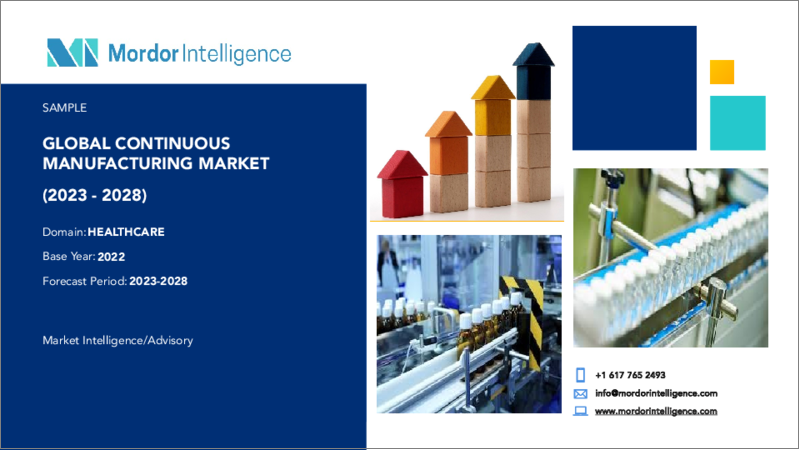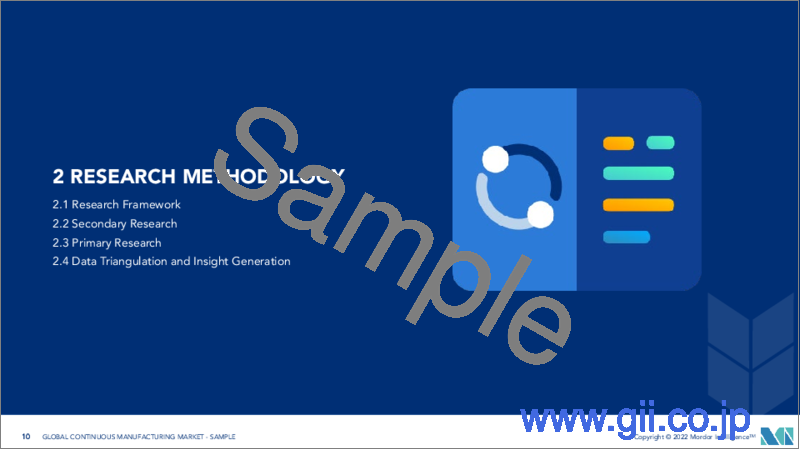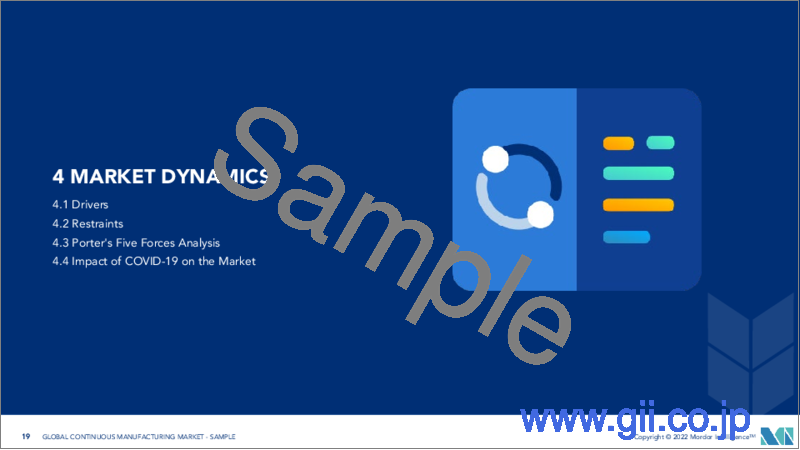|
|
市場調査レポート
商品コード
1190444
連続生産市場- 成長、動向、予測(2023年~2028年)Continuous Manufacturing Market - Growth, Trends, and Forecasts (2023 - 2028) |
||||||
|
● お客様のご希望に応じて、既存データの加工や未掲載情報(例:国別セグメント)の追加などの対応が可能です。 詳細はお問い合わせください。 |
|||||||
| 連続生産市場- 成長、動向、予測(2023年~2028年) |
|
出版日: 2023年01月18日
発行: Mordor Intelligence
ページ情報: 英文 113 Pages
納期: 2~3営業日
|
- 全表示
- 概要
- 目次
連続生産市場は、予測期間(2022年~2027年)にCAGR12.8%で成長すると予測されています。
COVID-19の突然の発生により、医薬品の高い需要が発生しました。世界各地で厳しい閉鎖措置がとられたため、労働力と供給が不足し、その結果、医薬品の莫大な需要が発生しました。したがって、COVID-19の大流行は、継続的な製造に対する需要の増加につながり、それによって市場の成長に貢献しました。例えば、2021年9月に発表された「パンデミック効果:連続生産を現実に」と題する記事では、COVID-19パンデミックが進行し、低価格のワクチンやその他のパンデミック関連治療への需要が過去最高となっているため、大手製薬会社は連続生産を実現するための取り組みを強化していると言及しています。このように、COVID-19のパンデミックの発生は、市場の成長に大きな影響を及ぼしたのです。
連続生産は、低コストで薬剤の品質と一貫性を向上させる可能性があるため、調査された市場で人気を集めています。さらに、製薬業界における連続生産の適応と、世界の疾病の蔓延による投薬の需要増が、市場の成長を促進するものと思われます。連続生産は、メーカーが市場の需要を同時に満たすのに役立ち、製造コストを低下させます。
さらに、製造技術の進歩や政府機関からの支援は、研究市場の成長を後押しすると期待されています。また、連続生産に対する承認の増加も、市場の成長を後押しすると予想されます。例えば、2021年10月、米国食品医薬品局(FDA)は、連続生産を使用する4つの医薬品を承認し、これには、原薬に連続生産を使用する最初の規制適用が含まれていました。
さらに、市場関係者による協業の増加が、市場の成長を促進することが期待されます。例えば、2020年9月、EmersonとIntegra CMSは、連続医薬品製造の採用を加速させるために協業しています。
したがって、上記の要因は、予測期間中に調査対象市場の成長を促進することが期待されます。しかし、連続生産の適応の遅さ、規制、ガイドラインに関する技術的な明確さの欠如は、予測期間中の市場成長を阻害する可能性があります。
連続生産の市場動向
統合型連続生産は予測期間中に大きな成長を遂げると予測される
多くの製薬企業やヘルスケア企業が、自動化と人的干渉を最小限に抑えた連続生産技術を採用しています。さらに、この統合された連続生産は、製造コストと時間を削減し、マージンを増加させることでメーカーに利益をもたらしています。
2021年1月に発表された「Continuous manufacturing versus batch manufacturing:benefits, opportunities for manufacturers and regulators」という記事によると、連続生産の処理速度と制御の向上とともに、特に大量生産では生産コストを下げ、多大なコスト優位性を付与することになると思われます。
連続生産では、原材料をシステムに投入し、最終製品を連続的に生産します。これにより、メーカーは需要に迅速に対応することができます。既存の製造技術を改善するための政府による企業への投資の増加や、製薬メーカーの増加などが、予測期間中の市場成長を後押ししています。例えば、2021年1月、Continuus Pharmaceuticalsは、重症患者の治療に不可欠な医薬品の国内生産を促進するために、米国政府から6930万米ドルの契約を受領しました。製造受託機関は、発展途上地域における製造受託機関の増加により、予測期間中に顕著な成長率を記録すると予想されます。さらに、医薬品の承認件数の増加や、研究市場の需要に対応するための製造施設の増加の必要性も、市場の成長を後押しすると予想されます。
このように、上記の要因は予測期間中、市場における調査対象セグメントの成長を促進すると予想されます。
北米が市場を独占し、予測期間中も同様の傾向が続くと予想される
北米は、主要な市場プレイヤーの存在と高度な技術の利用可能性により、予測期間中に大きな市場シェアを占めると予測されます。さらに、良好な規制インフラと医薬品に対する高い需要が、同地域の市場成長を後押しすると予測されます。さらに、同地域の製薬会社やバイオテクノロジー企業における研究開発への高い投資は、同地域の市場成長を後押しすると予測されます。例えば、2022年6月、National Resilience Inc.はシリーズDファイナンスで6億2500万米ドルを調達し、この資金は生物製剤の連続生産に一部充てられる予定です。同様に、より大きな市場シェアを獲得するための提携など、台頭する市場プレイヤーの戦略も、この地域の市場成長を促進するものと思われます。例えば、2022年5月、アジレントは、液体クロマトグラフィーを介した自動プロセス分析をサポートする独自のワークフローを顧客に提供するために、両社の技術を組み合わせることに取り組むために、APC Ltd.と協業しました。
さらに、政府組織からの支援の増加も、この地域の研究市場の成長を促進すると予想されます。例えば、2021年10月に米国下院は、全国の様々な大学における連続生産の卓越性のための国立センターの創設を通じて高度な製造を促進する法案、H.R. 4369を通過させました。
したがって、上記の要因は、この地域における予測期間中の市場の成長を促進することが期待されます。
連続生産市場の競合分析
連続生産市場は、メーカー数が限られているため、競争は緩やかです。市場参加者は、製造コストの削減と効率化のために、自動化と製品製造技術の融合に注力しています。調査対象の市場プレイヤーには、GEA Group AG、Robert Bosch GmbH、Glatt GmbH、Thermo Fisher Scientific、Siemensなどが含まれます。
その他の特典
- エクセル形式の市場予測(ME)シート
- アナリストによる3ヶ月間のサポート
目次
第1章 イントロダクション
- 調査の前提条件と市場の定義
- 調査対象範囲
第2章 調査手法
第3章 エグゼクティブサマリー
第4章 市場力学
- 市場概要
- 市場促進要因
- 生産コストの削減と品質の向上
- 世界各国の規制当局からのサポート
- 市場抑制要因
- 規制および技術的な明確性の欠如
- 産業界における適応の遅さと硬直性
- ファイブフォース分析分析
- 新規参入業者の脅威
- 買い手/消費者の交渉力
- 供給企業の交渉力
- 代替品の脅威
- 競争企業間の敵対関係
第5章 市場セグメンテーション(金額ベース市場規模:100万米ドル)
- 製品別
- 統合連続生産
- 半連続生産
- 連続式ブレンダー
- 連続式造粒機
- 連続塗工機
- 連続式コンプレッサ
- 連続式ドライヤー
- その他半連続式製造装置
- アプリケーション別
- 原薬製造
- 最終製品製造
- エンドユーザー別
- 受託製造企業
- 製薬会社
- その他エンドユーザー
- 地域別
- 北米
- 米国
- カナダ
- メキシコ
- 欧州
- ドイツ
- 英国
- フランス
- イタリア
- スペイン
- その他の欧州地域
- アジア太平洋地域
- 中国
- 日本
- インド
- オーストラリア
- 韓国
- その他アジア太平洋地域
- 中東・アフリカ地域
- GCC
- 南アフリカ
- その他中東地域
- 南米地域
- ブラジル
- アルゼンチン
- その他の南米地域
- 北米
第6章 競合情勢
- 企業プロファイル
- Siemens Healthineers
- GEA Group AG
- Robert Bosch GmbH
- Glatt GmbH
- Thermo Fisher Scientific
- Munson Machinery Co. Inc.
- Coperion GmbH
- Scott Equipment Company
- HOSOKAWA MICRON CORP.
- Sturtevant Inc
- L.B Bohle
第7章 市場機会と今後の動向
The continuous manufacturing market is projected to register a CAGR of 12.8% during the forecast period (2022 - 2027).
The sudden onset of Covid-19 resulted in high demand for pharmaceuticals. The imposition of strict lockdowns across the globe resulted in the lack of labor and supply thereby resulting in the huge demand for pharmaceuticals. Hence, the COVID-19 pandemic led to increasing demand for continuous manufacturing, thereby contributing to the growth of the market. For instance, the article titled "The pandemic effect: making continuous manufacturing a reality" published in September 2021 mentioned that with the ongoing COVID-19 pandemic and the increasing demand for low-cost vaccines and other pandemic-related treatments at an all-time high, big pharmaceutical companies are stepping up efforts to make continuous manufacturing a reality. Thus, the outbreak of the COVID-19 pandemic had a significant impact on the growth of the market.
Continuous manufacturing has been gaining traction in the market studied due to its potential to improve the quality and consistency of medication at lower costs. Furthermore, the adaptation of continuous manufacturing in the pharma industry and the rising demand for medication due to the growing prevalence of diseases around the world is likely to propel the market growth. Continuous manufacturing help manufacturers meet the market demand at the same time, which lowers the cost of manufacturing.
Moreover, technological advancements in manufacturing and support from government agencies are expected to bolster the studied market's growth. The increasing approval for continuous manufacturing is also expected to boost the growth of the market. For instance, in October 2021, United States Food and Drug Administration (FDA) approved four drugs using continuous manufacturing, which included the first regulatory application using continuous manufacturing for an active pharmaceutical ingredient.
Additionally, the increasing collaborations by the market players are expected to drive the growth of the market. For instance, in September 2020, Emerson and Integra CMS collaborated to accelerate the adoption of continuous pharmaceutical manufacturing.
Thus the above-mentioned factors are expected to drive the growth of the studied market during the forecast period. However, the slow adaptation of continuous manufacturing, lack of regulatory, and technical clarity regarding guidelines may impede the market growth of the market over the forecast period.
Continuous Manufacturing Market Trends
Integrated Continuous Manufacturing is Projected to Grow at Significant Rate Over the Forecast Period
Many pharmaceutical and healthcare manufacturing companies have been adopting continuous manufacturing technologies having automation and minimal human interference. Furthermore, this integrated continuous manufacturing has been benefiting the manufacturers by lowering the production costs, and time, and increasing their margins.
According to the article titled "Continuous manufacturing versus batch manufacturing: benefits, opportunities for manufacturers and regulators" published in January 2021, along with the increased processing speed and control of continuous manufacturing, it will lower the cost of production and grant tremendous cost advantages, especially with high-volume production.
In continuous manufacturing, raw materials are inserted into the system and the final product is produced continuously. This enables the manufacturers to respond quickly to demand. The rising government investments in the companies for improving their existing manufacturing technologies, and the rising number of pharmaceutical manufacturers have been fuelling market growth over the forecast period. For instance, in January 2021, Continuus Pharmaceuticals received a receipt of a USD 69.3 million contract from United States government to facilitate the domestic production of vital medicines to treat critically ill patients. Contract manufacturing organizations are expected to register a notable growth rate over the forecast period, owing to the increase in the number of contract manufacturing organizations in developing regions. Moreover, the escalating number of drug approvals and the need for more manufacturing facilities to meet the studied market's demand are anticipated to boost the market growth.
Thus, the above-mentioned factors are expected to drive the growth of the studied segment in the market during the forecast period.
North America Dominates the Market and is Expected to Continue the Same Over the Forecast Period
North America is projected to have a significant market share over the forecast period, owing to the presence of key market players and the availability of advanced technologies. Furthermore, favorable regulatory infrastructure and high demand for medicine are projected to boost the market growth in the region. Moreover, high investment in research and development in pharma and biotechnological companies in the region is projected to boost the market growth in the region. For instance, in June 2022, National Resilience Inc. raised USD 625 million in series D financing, which would be spent in part on continuous manufacturing for biologics. Similarly, the rising market player's strategies such as collaborations to obtain a larger market share are also expected to drive the growth of the market in this region. For instance, in May 2022, Agilent collaborated with APC Ltd., for working towards combining their technologies to provide unique workflows to customers that support automated process analysis via liquid chromatography.
Additionally, the increasing support from government organizations is also expected to drive the growth of the studied market in this region. For instance, in October 2021 United States House of Representatives passed a bill, H.R. 4369 that promotes advanced manufacturing through the creation of national centers for excellence in continuous manufacturing at various universities across the country.
Thus, the above-mentioned factors are expected to drive the growth of the market during the forecast period in this region.
Continuous Manufacturing Market Competitive Analysis
The continuous manufacturing market is moderately competitive having a limited number of manufacturers. The market players have been focusing on merging automation with product manufacturing technologies to reduce manufacturing costs and improve efficiency. The market players operating in the market studied include GEA Group AG, Robert Bosch GmbH, Glatt GmbH, Thermo Fisher Scientific, and Siemens, among others.
Additional Benefits:
- The market estimate (ME) sheet in Excel format
- 3 months of analyst support
TABLE OF CONTENTS
1 INTRODUCTION
- 1.1 Study Assumptions and Market Definition
- 1.2 Scope of the Study
2 RESEARCH METHODOLOGY
3 EXECUTIVE SUMMARY
4 MARKET DYNAMICS
- 4.1 Market Overview
- 4.2 Market Drivers
- 4.2.1 Less Cost and Better Quality of Production
- 4.2.2 Support from Regulatory Authorities Around the World
- 4.3 Market Restraints
- 4.3.1 Lack of Regulatory and Technical Clarity
- 4.3.2 Slow adaptation and Rigidity Among the Industries
- 4.4 Porter's Five Forces Analysis
- 4.4.1 Threat of New Entrants
- 4.4.2 Bargaining Power of Buyers/Consumers
- 4.4.3 Bargaining Power of Suppliers
- 4.4.4 Threat of Substitute Products
- 4.4.5 Intensity of Competitive Rivalry
5 MARKET SEGMENTATION (Market Size by Value - USD million)
- 5.1 By Product
- 5.1.1 Integrated Continuous Manufacturing
- 5.1.2 Semi Continous Manufacturing
- 5.1.2.1 Continuous Blenders
- 5.1.2.2 Continuous Granulators
- 5.1.2.3 Continuos Coaters
- 5.1.2.4 Continuous Compressors
- 5.1.2.5 Continuous Dryers
- 5.1.2.6 Other Semi-continuous Manufacturing Products
- 5.2 By Application
- 5.2.1 API Manufacturing
- 5.2.2 End Product Manufacturing
- 5.3 By End User
- 5.3.1 Contract Manufacturers
- 5.3.2 Pharmacuitical Companies
- 5.3.3 Other End Users
- 5.4 Geography
- 5.4.1 North America
- 5.4.1.1 United States
- 5.4.1.2 Canada
- 5.4.1.3 Mexico
- 5.4.2 Europe
- 5.4.2.1 Germany
- 5.4.2.2 United Kingdom
- 5.4.2.3 France
- 5.4.2.4 Italy
- 5.4.2.5 Spain
- 5.4.2.6 Rest of Europe
- 5.4.3 Asia-Pacific
- 5.4.3.1 China
- 5.4.3.2 Japan
- 5.4.3.3 India
- 5.4.3.4 Australia
- 5.4.3.5 South Korea
- 5.4.3.6 Rest of Asia-Pacific
- 5.4.4 Middle East and Africa
- 5.4.4.1 GCC
- 5.4.4.2 South Africa
- 5.4.4.3 Rest of Middle East and Africa
- 5.4.5 South America
- 5.4.5.1 Brazil
- 5.4.5.2 Argentina
- 5.4.5.3 Rest of South America
- 5.4.1 North America
6 COMPETITIVE LANDSCAPE
- 6.1 Company Profiles
- 6.1.1 Siemens Healthineers
- 6.1.2 GEA Group AG
- 6.1.3 Robert Bosch GmbH
- 6.1.4 Glatt GmbH
- 6.1.5 Thermo Fisher Scientific
- 6.1.6 Munson Machinery Co. Inc.
- 6.1.7 Coperion GmbH
- 6.1.8 Scott Equipment Company
- 6.1.9 HOSOKAWA MICRON CORP.
- 6.1.10 Sturtevant Inc
- 6.1.11 L.B Bohle




